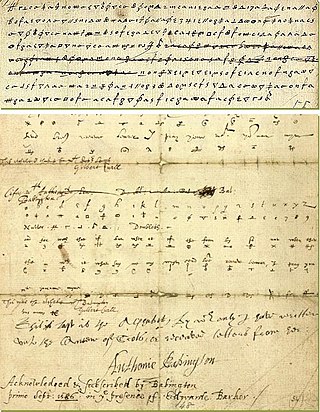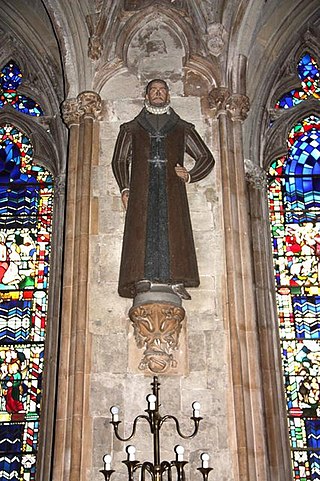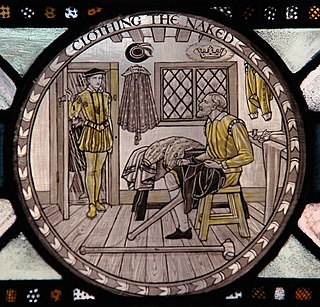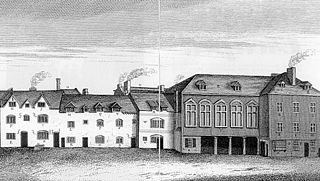Related Research Articles

The Babington Plot was a plan in 1586 to assassinate Queen Elizabeth I, a Protestant, and put Mary, Queen of Scots, her Catholic cousin, on the English throne. It led to Mary's execution, a result of a letter sent by Mary in which she consented to the assassination of Elizabeth.

Robert Southwell, SJ, also Saint Robert Southwell, was an English Catholic priest of the Jesuit Order. He was also an author of Christian poetry in Elizabethan English, and a clandestine missionary in Elizabethan England.
Richard Topcliffe was a priest hunter and practitioner of torture during the reign of Elizabeth I of England. A landowner and Member of Parliament, he became notorious as the government's chief enforcer of the penal laws against the practice of Catholicism.

John Jones O.F.M, also known as John Buckley, John Griffith, Godfrey Maurice, or Griffith Jones, was a Franciscan priest and martyr. He was born at Clynnog Fawr, Caernarfonshire (Gwynedd), Wales, and was executed 12 July 1598 at Southwark, England. He is one of the Forty Martyrs of England and Wales.
The Dryburne Martyrs: Richard Hill, Richard Holiday, John Hogg and Edmund Duke were English Roman Catholic priests and martyrs, executed at Dryburne, County Durham, in the reign of Elizabeth I. They were beatified by Pope John Paul II in 1987.
Richard Leigh was an English Roman Catholic martyr born in Cambridge, the scion of Cheshire gentry, squires of the West Hall, High Legh since the 11th century.
Jerome Bellamy, of Uxenden Hall, near London, England, was a member of an old Roman Catholic recusant family noted for its hospitality to missionaries and fellow recusants.

Swithun Wells was an English Roman Catholic martyr who was executed during the reign of Elizabeth I. Wells was a country gentleman and one time schoolmaster whose family sheltered hunted priests. He himself often arranged passage from one safehouse to another. His home in Gray's Inn Lane was known to welcome recusants.
Henry More (1586–1661) was an English Jesuit provincial and church historian.
Richard Creagh was an Irish Roman Catholic clergyman who was the Archbishop of Armagh and Primate of All Ireland during the reign of Queen Elizabeth I. Along with the other Irish Catholic Martyrs, Archbishop Creagh is under investigation for possible Roman Catholic Sainthood. His current title is Servant of God.

Nicholas Horner was an English Roman Catholic layman, hanged, drawn and quartered because he had "relieved and assisted" Christopher Bales, a seminary priest. A tailor by trade, he was charged with making a jerkin for a priest. Horner maintained that the customer was a stranger and he didn't know who he was. Horner is recognized as a Catholic martyr, beatified in 1987.
Richard Sergeant (executed at Tyburn, 20 April 1586) was an English Roman Catholic priest. He is a Catholic martyr, beatified in 1987.

Hindlip Hall is a stately home in Hindlip, Worcestershire, England. The first major hall was built before 1575, and it played a significant role in both the Babington and the Gunpowder plots, where it hid four people in priest holes. It was Humphrey Littleton who told the authorities that Edward Oldcorne was hiding here after he had been heard saying Mass at Hindlip Hall. Four people were executed and the owner at that time barely escaped execution himself due to the intercession of Lord Monteagle.

Richard Shelley was an English recusant who presented to Elizabeth I of England, or her Parliament, a petition drawn up to request greater religious tolerance for Roman Catholics. The details being disputed, he was imprisoned and died.
Richard Langley was an English Roman Catholic layman, condemned for sheltering Catholic priests. He is a Catholic martyr, beatified in 1929.

The Oaten Hill Martyrs were Catholic Martyrs who were executed by hanging, drawing and quartering at Oaten Hill, Canterbury, on 1 October 1588. The gallows had been put up in 1576. These four were beatified by Pope Pius XI in 1929.
Thomas Holford (1541–1588) was an English Protestant schoolteacher who became a Catholic priest during the reign of Queen Elizabeth I. He was martyred at Clerkenwell in London, and is recognised by the Catholic Church as having the status of Blessed.
Richard Martin was an English martyr. A layman, Martin was charged with being a "receiver and maintainer of priests" for having bought supper for Robert Morton, a priest.
Henry Vaux was an English recusant, priest smuggler, and poet during the reign of Elizabeth I. He was the eldest child of William Vaux, 3rd Baron Vaux of Harrowden. His first wife, Elizabeth Beaumont, was the daughter of John Beaumont of Grace Dieu, Leicester. Both of Vaux's parents came from traditionally Catholic families.
References
- ↑ "Robert Southwell, Venerable". The Original Catholic Encyclopedia. Retrieved 9 June 2010.
- ↑ P. H. Reaney (1969). The Origin of English Place Names. Routledge and Kegan Paul. p. 103. ISBN 0-7100-2010-4.
- ↑ Taaffe, Thomas. "Jerome Bellamy" The Catholic Encyclopedia Vol. 2. New York: Robert Appleton Company, 1907. 26 March 2020
 This article incorporates text from this source, which is in the public domain .
This article incorporates text from this source, which is in the public domain . - ↑ Cass, Frederick Charles (1880). Monken Hadley. J.B. Nichols and Sons. p. 137.
 This article incorporates text from this source, which is in the public domain .
This article incorporates text from this source, which is in the public domain . - ↑ Ben Weinreb; Christopher Hibbert (1993). The London Encyclopedia. Macmillan. p. 638. ISBN 0-333-57688-8.
- ↑ Brown, Nancy P. Southwell, Robert [St Robert Southwell] (1561–1595), writer, Jesuit, and martyr Oxford Dictionary of National Biography.
- ↑ Cass 1880, p. 139.